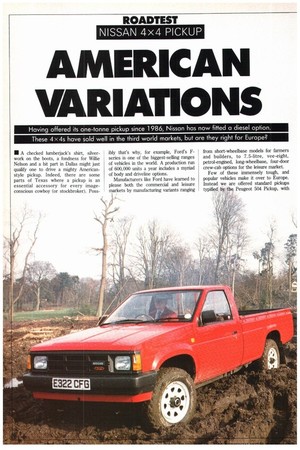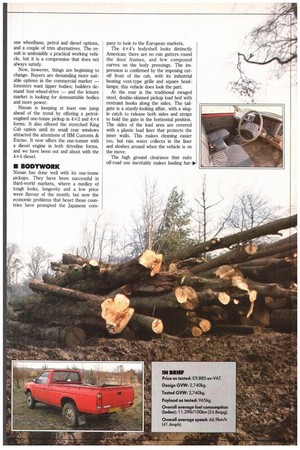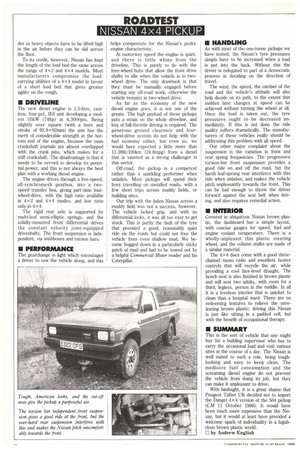AMERICAN VARIATIONS
Page 74

Page 75

Page 76

If you've noticed an error in this article please click here to report it so we can fix it.
Having offered its one-tonne pickup since 1986, Nissan has now fitted a diesel option. These 4 ,< 4s have sold well in the third world markets, but are they right for Europe?
• A checked lumberjack's shirt, silverwork on the boots, a fondness for Willie Nelson and a bit part in Dallas might just qualify one to drive a mighty Americanstyle pickup. Indeed, there are some parts of Texas where a pickup is an essential accessory for every imageconscious cowboy (or stockbroker). Poss ibly that's why, for example, Ford's Fseries is one of the biggest-selling ranges of vehicles in the world. A production run of 600,000 units a year includes a myriad of body and driveline options.
Manufacturers like Ford have learned to please both the commercial and leisure markets by manufacturing variants ranging from short-wheelbase models for farmers and builders, to 7.5-litre, vee-eight, petrol-engined, long-wheelbase, four-door crew-cab options for the leisure market.
Few of these immensely tough, and popular vehicles make it over to Europe. Instead we are offered standard pickups typified by the Peugeot 504 Pickup, with one wheelbase, petrol and diesel options, and a couple of trim alternatives. The result is undeniably a practical working vehicle, but it is a compromise that does not always satisfy.
Now, however, things are beginning to change. Buyers are demanding more suitable options in the commercial market — foresters want tipper bodies; builders demand four-wheel-drive — and the leisure market is looking for demountable bodies and more power.
Nissan is keeping at least one jump ahead of the trend by offering a petrolengined one-tonne pickup in 4x2 and 4x4 forms. It also offered the stretched King Cab option until its small rear windows attracted the attentions of HM Customs & Excise. It now offers the one-tonner with a diesel engine in both driveline forms, and we have been out and about with the 4 x 4 diesel.
• BODYWORK
Nissan has done well with its one-tonne pickups. They have been successful in third-world markets, where a medley of tough looks, longevity and a low price were flavour of the month; but now the economic problems that beset those countries have prompted the Japanese corn pony to look to the European markets.
The 4 x4's bodyshell looks distinctly American; there are no rain gutters round the door frames, and few compound curves on the body pressings. The impression is confirmed by the imposing cutoff front of the cab, with its industrial heating vent-type grille and square headlamps; this vehicle does look the part.
At the rear is the traditional swaged steel, double-skinned pickup load bed with restraint hooks along the sides. The tailgate is a sturdy-looking affair, with a single catch to release both sides and straps to hold the gate in the horizontal position. The sides of the load area are covered with a plastic load liner that protects the inner walls. This makes cleaning easier too, but rain water collects in the liner and sloshes around when the vehicle is on the move.
The high ground clearance that suits off-road use inevitably makes loading har-lp. der as heavy objects have to be lifted high in the air before they can be slid across the floor.
To its credit, however, Nissan has kept the length of the load bed the same across the range of 4x2 and 4x4 models. Most manufacturers compromise the loadcarrying abilities of a 4x4 model in favour of a short load bed that gives greater agility on the rough.
• DRIVELINE
The new diesel engine is 2.5-litre, castiron, four-pot, IDE unit developing a modest 55kW (74hp) at 4,300rpm. Being slightly over square (with a bore and stroke of 92.9x92mm) the unit has the merit of considerable strength at the bottom end of the engine, because the main crankshaft journals are almost overlapped with the crank pins, which makes for a stiff crankshaft. The disadvantage is that it needs to be revved to develop its potential power, and this is not always the best plan with a working diesel engine.
The engine drives through a five-speed, all-synchromesh gearbox, into a twospeed transfer box, giving part-time fourwheel-drive, with the high ratio available in 4x2 and 4x4 modes, and low ratio only in 4x4.
The rigid rear axle is supported by multi-leaf semi-elliptic springs, and the solidly-mounted front differential drives the constant velocity joint-equipped driveshafts. The front suspension is independent, via wishbones and torsion bars.
• PERFORMANCE
The gearchange is light which encourages a driver to row the vehicle along, and this helps compensate for the Nissan's peaky engine characteristic.
At motorway speed the engine is quiet, and there is little whine from the driveline. This is purely to do with the free-wheel hubs that allow the front drive shafts to idle when the vehicle is in twowheel drive. The only drawback is that they must be manually engaged before starting any off-road work, otherwise the vehicle remains in two-wheel drive.
As far as the economy of the new diesel engine goes, it is not one of the greats. The high payload of these pickups puts a strain on the whole driveline, and lots of full-throttle driving is required. The generous ground clearance and fourwheel-drive system do not help with the fuel economy either, but even so, we would have expected a little more than 11.391it/1001un (24.8mpg) from a diesel that is vaunted as a strong challenger in this sector.
Off-road, the pickup is a competent rather than a sparkling performer when unladen. Most pickups will spend their lives travelling on metalled roads, with a few short trips across muddy fields, or building sites.
Our trip with the laden Nissan across a muddy field was not a success, however. The vehicle lacked grip, and with no differential locks, it was all too easy to get stuck. This is partly the fault of the tyre that provided a good, reasonably quiet ride on the roads but could not free the vehicle from even shallow mud. We became bogged down in a particularly sticky patch of mud and had to be towed out by a helpful Commercial Motor reader and his Caterpillar.
• HANDLING
As with most of the one-tonne pickups we have tested, the Nissan's tyre pressures simply have to be increased when a load is put into the back. Without this the driver is relegated to part of a democratic process in deciding on the direction of travel.
The wind, the speed, the camber of the road and the vehicle's attitude will also help decide on its path, to the extent that sudden lane changes at speed can be achieved without turning the wheel at all. Once the load is taken out, the tyre pressures ought to be decreased immediately. If this is not done the ride quality suffers dramatically. The manufacturers of these vehicles really should be addressing this problem with all speed.
Our other major complaint about the suspension is the variation in front and rear spring frequencies. The progressive torsion-bar front suspension provides a good ride on and off the road, but the harsh leaf-sprung rear interferes with this ride when unladen, and makes the vehicle pitch unpleasantly towards the front. This can be bad enough to throw the driver forward against the seat belt when driving, and also requires remedial action.
• INTERIOR
Covered in ubiquitous Nissan brown plastic, the dashboard has a simple layout, with concise gauges for speed, fuel and engine coolant temperature. There is a wholly-unpleasnt thin plastic steering wheel, and the column stalks are made of a similar material.
The 4 x 4 does come with a good threechannel mono radio and excellent heater controls that will recycle the air, while providing a cool face-level draught. The bench seat is also finished in brown plastic and will seat two adults, with room for a third, legless, person in the middle. In all it is a loveless interior that is quicker to clean than a hospital ward. There are no redeeming features to relieve the unrelenting brown plastic; driving this Nissan is just like sitting in a padded cell, but with the benefit of occupational therapy.
• SUMMARY
This is the sort of vehicle that one might buy for a building supervisor who has to carry the occasional load and visit various sites in the course of a day. The Nissan is well suited to such a role, being toughlooking and easy to keep clean. The mediocre fuel consumption and the screaming diesel engine do not prevent the vehicle from doing its job, but they can make it unpleasant to drive.
With hindsight, it is a great shame that Peugeot Talbot UK decided not to import the Dangel 4x4 version of the 504 pickup (CM 11 October 1986). It would have been much more expensive than the Nissan, but it would at least have provided a welcome spark of individuality in a lugubrious brown plastic world.
0 by Andrew English
















































































































